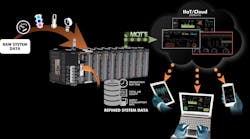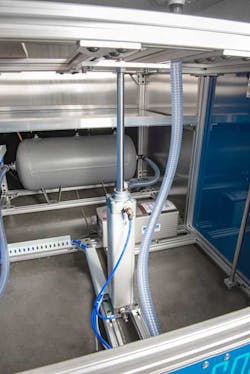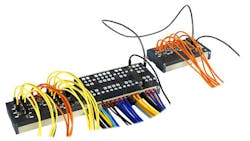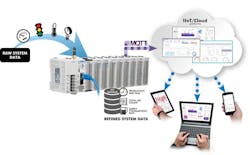As an original equipment manufacturer (OEM) or end-user of equipment, what are the most important operational qualities that should be built into machines? For many people, top-of-mind attributes would include safety, maximum uptime, ease of use and maintenance, and efficient operation. But another topic is trending as an increasingly must-have feature—Industrial Internet of Things (IIoT) connectivity.
Whether new or existing equipment uses PLCs, other microcontrollers or even basic hardwired circuits, the design goal for automated machinery has long been safe and reliable operation. Connecting with the machine and sensor data, and then transmitting this information somewhere to be viewed and analyzed—key IIoT capabilities—has been a secondary consideration.
Today’s sophisticated end-users look for as much data as possible to visualize what is happening at the machine and to then operate it most effectively. For both new and retrofit machine automation projects, intelligent solenoid manifolds and cloud-capable PLCs are now available to help facilitate IIoT data connectivity.
End-users and OEMs are finding it easy to add IIoT capabilities to their pneumatic equipment and other automated systems. Regardless of the make, model or age of the equipment and associated controllers, there are intelligent devices and cloud-enabled PLCs making this not only possible, but practical.
Show me the Data
Designing IIoT connectivity into new equipment is usually a little easier than retrofitting it into existing machines because all the latest products can be used. But there is a lot more existing than new equipment, and the underlying IIoT principals are the same in either case.
Fortunately, new controller and intelligent field device technologies are including built-in ways to make data available for both new and retrofit projects. Here are just a few types of IIoT data that can be provided by machines and equipment:
- Running, stopped and waiting status.
- Alarm signals.
- Cycle counts and rates.
- Intelligent solenoid and variable frequency drive diagnostics.
In the most basic sense, this data is useful if it can simply be visualized using human-machine interface software, a mobile app or a web page. Data handling and storage can be localized on-premises, but it is often more convenient in terms of accessibility and administration if the data is connected with cloud storage and services.
Beyond basic visualization, other roles for data include historical logging, event logging, reporting and deeper analysis. Useful analytics take effort to implement, but can help warn about pressure fluctuations, potential leaks and unexpectedly slow-moving cylinders or other pneumatic devices.
To make all this possible, there needs to be a way to monitor the signals, and a way to transmit them to the cloud.
Simple and Smart Signals
The most basic way to monitor field signals is by using traditional I/O connections, which might be discrete (on/off) or analog (variable). Some signals may already be wired to existing automation, but other data points of interest, such as electrical and compressed air sensors, might need to be added.
For example, a pneumatic machine (Fig. 1) already in service may only use a low-pressure switch to stop operation if the air pressure goes too low. Adding a pressure transmitter to obtain an actual pressure value would allow comparison of machine performance in relation to the air supply. One approach to accomplish this is to add the sensor and wire it to the existing I/O, and to then modify the existing controller—if there are spare I/O points, and if modifying the PLC program won’t impact the equipment warranty.
An alternate is to add new remote I/O modules, or a PLC with I/O, to gather these points separately from the existing control system, and effectively in parallel with it. We will look at the PLC option in the next section, but a main reason this “add on” approach is so attractive is because it does not affect the existing automation in any meaningful way.
The proliferation of smart field devices is revolutionizing how field signals can be monitored. Many devices include Ethernet or Wi-Fi connectivity, so they can talk directly to the cloud or be consolidated under an IIoT PLC. Even traditional automation elements like solenoid manifolds need not be hardwired to I/O anymore because they are available with on-board communication modules designed to interact well with PLCs using common industrial protocols, like EtherNet/IP (Fig. 2). This reduces field wiring and makes it easier to create IIoT solution installations, and it provides many options for OEMs and system designers to distribute pneumatics and I/O in an organized way throughout an automated machine or system.
Not only are basic on/off commands available, but these manifolds can provide extended diagnostic data about the hardware, and some of them can accept I/O modules to provide an all-in-one remote I/O solution. Intelligent pneumatics and I/O are especially useful for new installations.
PLC Cloud Connection
Whether the signals for new or retrofit installations will be simple or smart, it is typically necessary to provide additional computing to create an IIoT project. In past years this has often required specialized gateway devices, or even industrial PCs. Modern PLCs now have what it takes to enable field-to-cloud connectivity in a more streamlined manner.
PLCs are already ideal for the operating environment because they are built robustly and have many I/O and industrial field bus options. Most newer models use Ethernet, and some even include Wi-Fi and/or Bluetooth for improved ease-of-installation and configuration. Wireless connectivity is a significant advantage because it enables quick and inexpensive installations, avoiding the downsides of traditional conduit and cable installation in the field.
One important cloud-ready upgrade in recent years is the addition of the IT-friendly MQTT protocol, which has become the preferred method for communicating data to the cloud (Fig. 3).
A modern PLC can provide the control and data capabilities for new equipment designs. Versions are available which let users easily, economically and securely add IIoT connectivity to existing machines without impacting the underlying automation. Depending on the PLC feature set, the data can be transmitted to a IIoT cloud service or the user’s own database and analytics systems, and some models are certified to work directly and natively with cloud services.
IIoT-Empowered Equipment
In addition to specifying new equipment with convenient built-in communications, many end-users and OEMs are finding it easy to add IIoT capabilities to their pneumatic equipment and other automated systems. Regardless of the make, model or age of the equipment and associated controllers, there are intelligent devices and cloud-enabled PLCs making this not only possible, but practical.
Not only is this approach flexible, but it is also modular and scalable. Users, systems integrators and OEMs can add IIoT functionality on a trial basis, and then roll it out on a much larger scale when proven. And they can incrementally add new signals as experience develops. With an IIoT system in place, users have the information they need to run efficiently. They can receive early indications of developing problems, using this information to reduce downtime for maintenance and repair.
Kevin Kakascik is a technical marketing engineer at AutomationDirect. Over his 20-year career he has held controls engineering positions for machine OEMs, entertainment industry systems integrators and material handling systems integrators where he estimated, designed, commissioned and started up systems.




